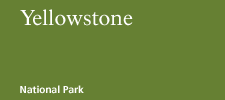|
Q. How high is Tower Fall?
A. 132 feet
Q. How did the (basalt) columns form (at Calcite Springs)?
A. The formation you see across the Yellowstone River was formed by a basaltic lava flow that cracked into the hexagonal columns, or "fence posts," as it slowly cooled. Similar basalt columns can be seen at the Sheepeater Cliffs along the Gardner River between Mammoth and Norris.
Q. How long is the trail to the bottom of Tower Fall?
A. From the Tower Fall overlook, the trail to the bottom (a much better view, by the way) is one-mile round trip. The trail descends about 300 feet in a half mile. Coming back out is steep and somewhat strenuous. If you have heart, lung, or knee problems you may want to enjoy the view from the top.
Q. How did the (petrified) trees get petrified?
A. Although the process of petrification is not completely understood, we do know that certain elements are required. First, the tree must be rapidly buried in order to minimize decay of the organic (woody) material. The petrified trees of Yellowstone were buried by volcanic deposits and mudflows associated with volcanic eruptions 45-50 million years ago. Second, there needs to be a concentration of silica in the groundwater surrounding the buried tree. In Yellowstone, silica-rich groundwater soaked into the trees, filling in the spaces between wood cells, and eventually hardening. The actual woody material is still there. Paleodendrochronologists (scientists who study ancient trees) can determine the species of tree by applying an acid solution to thin slices of the petrified material. The acid eats away the silica, leaving the woody material relatively intact. By studying this remaining cellular material, scientists can tell us, for instance, that a particular tree was a redwood. Lastly, erosion must uncover the tree so we can see it! In Yellowstone, glacial ice and the eroding power of running water and wind have uncovered the vast areas of fossil forests. There are undoubtedly many fossilized trees still underground that have not been exposed by erosion.
| 




